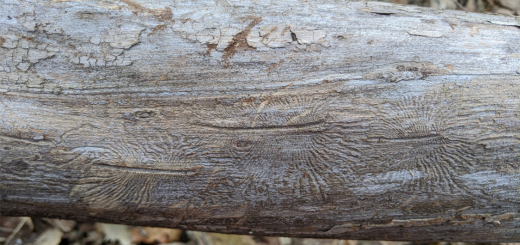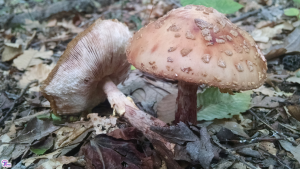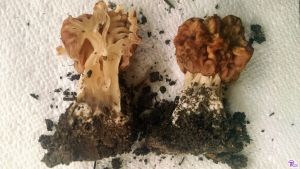#143: Boletinellus merulioides, the Ash Tree Bolete [Archived]
Note: This is an archived post. You can find the current version of this post here.
Boletinellus merulioides is an odd mushroom, both in appearance and ecology. The Ash Tree Bolete can be readily identified by its pore surface – which is only a few millimeters thick and looks more like a network of ridges – and by the fact that it fruits only under ash trees. merulioides appears under ash because it has a unique symbiotic relationship with a pest of ash trees: the Leafcurl Ash Aphid.
The Ash Tree Bolete is a medium to large bolete with an irregular shape, off-center to lateral stipe, and very thin pore surface. The cap is roughly circular, but is often lobed and wavy or even somewhat kidney-shaped when the stipe is close to the edge of the cap. It is mostly convex when newly-formed but becomes flat or even vase-shaped as it ages. On the top, the Ash Tree Bolete is smooth and leathery and is colored brown with shades of yellow or red.
The mushroom’s pore surface is yellowish to brownish green. The pores are unusually shallow for boletes and may appear more like reticulation or a network of ridges than fully-formed pores. They run down the stipe and are roughly arranged like gills, with the longest axis of the pore pointing toward the stipe. In some specimens, the pores may actually look more like gills with many cross-veins. The spores are produced on the pore surface and are olive brown when deposited en masse.
Unlike nearly every other bolete, the Ash Tree Bolete has a stipe that is rarely in the center of the cap. More often than not, the stipe is off-center (eccentric) and is sometimes found at the edge of the pileus (lateral). The stipe is only 2-4cm (1-2in) tall, making the mushroom rather short and stocky. Below the end of the pore surface, the stipe is dark brown or the same color as the cap. All surfaces bruise brownish or sometimes bluish. The mushroom’s flesh is soft, is colored whitish or yellowish, and may or may not bruise brown or blue.
Perhaps the most interesting feature of this mushroom is its relationship with the Leafcurl Ash Aphid (Prociphilus fraxinifolii, also listed as Meliarhizophagus fraxinifolii). The aphids feed on leaves of ash trees, where they cause the leaves to curl. More importantly for B. merulioides, the aphids also feed on roots of ash trees. The fungus actually protects the underground aphids by encasing them in a small, dark-colored knot of mycelium called a “sclerotium.” The sclerotia are roughly spherical and only 2 to 3mm in diameter. These structures are hollow and help protect the aphids from predators. Since the aphids feed off of ash roots, the sclerotia usually partially enclose the root. In return for protection, the fungus feeds off of the honeydew (essentially sugar-rich aphid poop) secreted by the aphids. This is a mutualistic relationship for the Ash Tree Bolete and the Leafcurl Ash Aphid.
Since the aphids feed only on ash trees, B. merulioides can be found exclusively under ash trees (Fraxinus spp.). The aphids and mushrooms are most commonly found under Green Ash (Fraxinus pennsylvanica), but can appear under any species of ash within their respective ranges. B. merulioides grows in eastern, northern, and possibly southwestern North America and appears in the summer and fall.
The Ash Tree Bolete belongs to the phylum Basidiomycota, class Agaricomycetes, order Boletales, family Boletinellaceae, and genus Boletinellus. However, the fungus has been transferred in and out of a number of different genera over the years. As a result, field guides often list this species as Gyrodon merulioides. The genus Boletinellus is one of the earliest diverging lineages of the boletes, indicating that B. merulioides is likely similar to ancestral boletes.
According to RogersMushrooms, B. merulioides is, “Edible but not very good.” Other websites have mixed reviews of the mushroom’s edibility. Although the mushrooms are interesting, these reviews indicate that the mushrooms are not worth eating. However, you can use them to dye wool. The Ash Tree Bolete will produce brown and orange colors, depending on the mordant used.
See Further:
http://www.rogersmushrooms.com/gallery/DisplayBlock~bid~5597.asp
http://www.mushroomexpert.com/boletinellus_merulioides.html
http://oregonstate.edu/dept/nurspest/woolyashaphid/introduction.htm








![#011: Characteristics of Kingdom Fungi [Archived]](https://www.fungusfactfriday.com/wp-content/themes/hueman/assets/front/img/thumb-small-empty.png)


